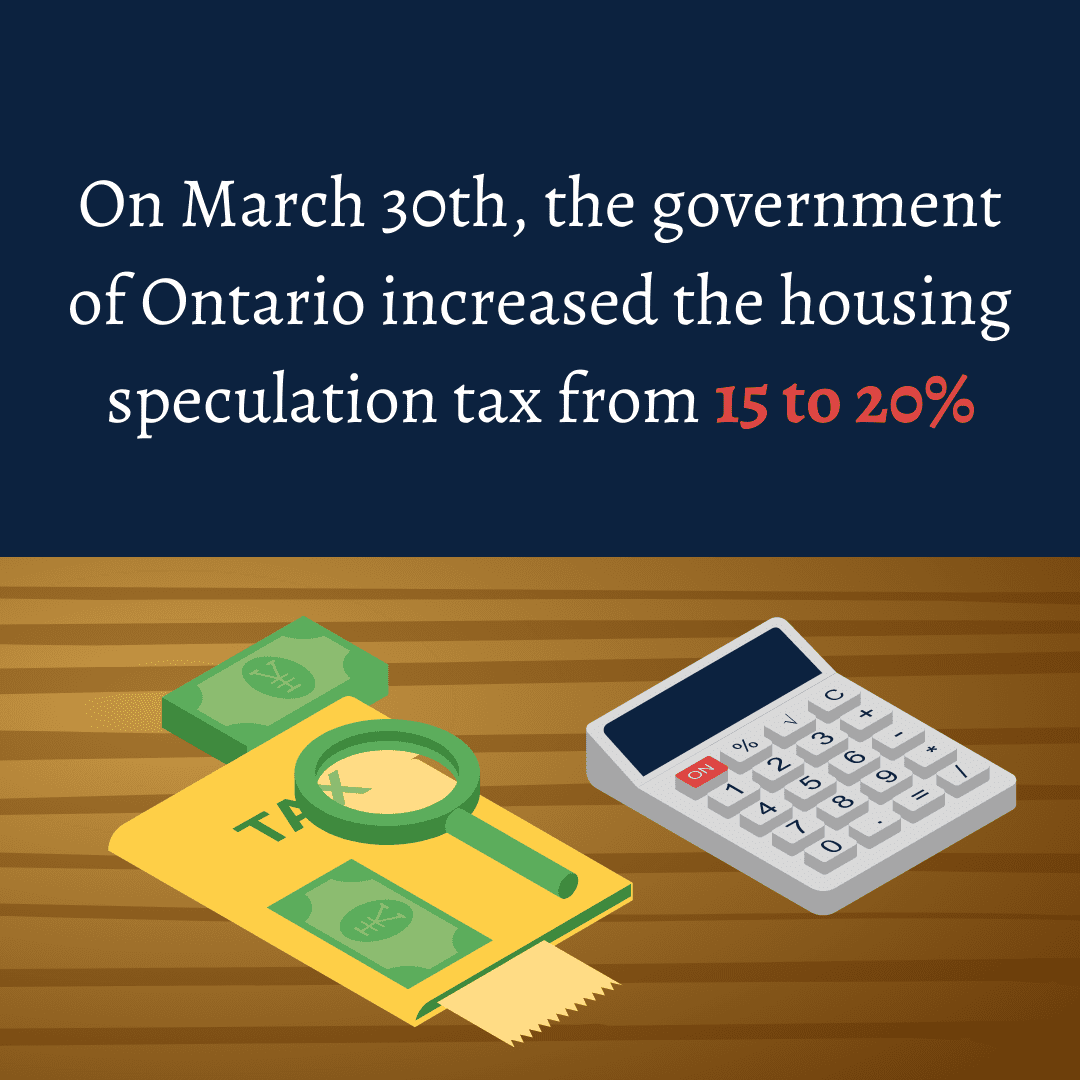
Mar
March 30th | Government of Ontario increased the housing speculation tax
Increasing Housing Supply
Since 2019, Ontario housing policy has taken aim at building more homes to support the growing population in Canada. Albeit their aims, municipalities are concerned with provincial oversight over local developments. In response, the Ontario government is actively working on the Housing Supply Working Group (HSWG) to engage with the federal government, ministries, and industry associations, to implement and monitor urban policies to increase housing supply.
In doing so, the government is focusing on building transit-oriented communities, by funding housing nearby transit and reducing dependence on cars. Developers may also be required to provide proof of infrastructure to support their developments (like sidewalks, parks, etc.). Surety bonds may also be allowed to be leveraged to finance developments to fulfil land-use obligations.
Expediting the Process
To expedite the process, the provincial government has invested up to $350 million in municipal planning and approvals processes. Further, the government is delegating planning to municipal professionals to accelerate the process; and seek to extend the review period from 30 to 60 days. Municipalities would also be allowed to reinstate expired approvals subject to units not being pre-sold, which could incentivize developers to avoid taking pre-construction offers. Furthermore, unapproved applicants are set to have their draft and rezoning application fees refunded starting January 1st, 2023, costing municipalities on overdue applications.

For expediting infrastructure and planning, the government is employing the Community and Housing Accelerator to override barriers preventing the development of agricultural lands. In support, the Environmental Registry of Ontario is overseeing various consultations on housing in rural areas, middle and multi-generational housing, financing for not-for-profit developers, and addressing illegal home building by non-Tarion registered builders.
Revising the Building Code
To facilitate construction, the government is revising the building code to allow for 12-storey mass timber buildings, speed up residential modular multi-unit approvals, reduce egress in residential buildings, and allowing lower-level tenants of super-tall buildings to move in while upper-levels are under construction.
The government is also engaged with municipalities to address staffing shortages in building officials and inspectors by making the qualification process simpler and easier.
Provincially Owned Lands for Community Housing
To increase community housing, the government is proposing the Centre of Realty Excellence (CORE) to focus on re-purposing over 1,000 acres of publicly owned real estate for community and social housing, namely for not-for-profit developments in the GTA.
The government is also considering whether the $6.2 billion infrastructure financing program is sufficient and being efficiently utilized for improving the state of social and community housing. Additionally, the government is investing an additional $1.3 billion in community housing and homelessness prevention.
Homeowners and Consumer Protection
To reduce foreign investments in the province, the government aims to increase the non-resident speculation tax rate from 15 to 20% effective March 30th, 2022. They are also seeking to close tax avoidance loopholes in provincial housing markets.

Further, they are engaged with municipalities to implement vacant home taxation to reduce vacancy rates in Canadian housing and are considering various means for reducing land speculation. For consumer protection, the government strives to hold builders and vendors to professional standards, increase various ethics violations and disciplinary fines, and enable Tarion to extend unfinished new build warranties.
Housing Prices
These provincial policies represent additional measures in government intervention on housing prices and supply constraints, to supplement recent credit rate hikes and taxation policies.
There is now a full-scale attack on Canadian home prices across various levels of policy… This market was feasting on low-1% rates through the pandemic. No longer.
– Senior economist Robert Kavcic of BMO
Overall, the effectiveness of these policies on cooling provincial and national real estate markets depends on various factors, such as credit liquidity and housing market exuberance. Albeit that, Real Estate experts claim that these policies are unlikely to cool Ontario housing markets, that as non-residents own below 5% of houses in Canada’s top housing markets, which implies that foreign investment is not the primary driver of Canadian housing prices.
Media Relations, The Lind Realty Team.
Do you have any questions concerning Ontario housing markets, or on the value of your home? Contact us, to learn more!
Government of Ontario (2022). More Homes for Everyone. Retrieved from https://www.ontario.ca/
BMO Capital Markets (2022). The Canadian Housing Dilemma – Views from the North. Retrieved from https://capitalmarkets.bmo.com/



